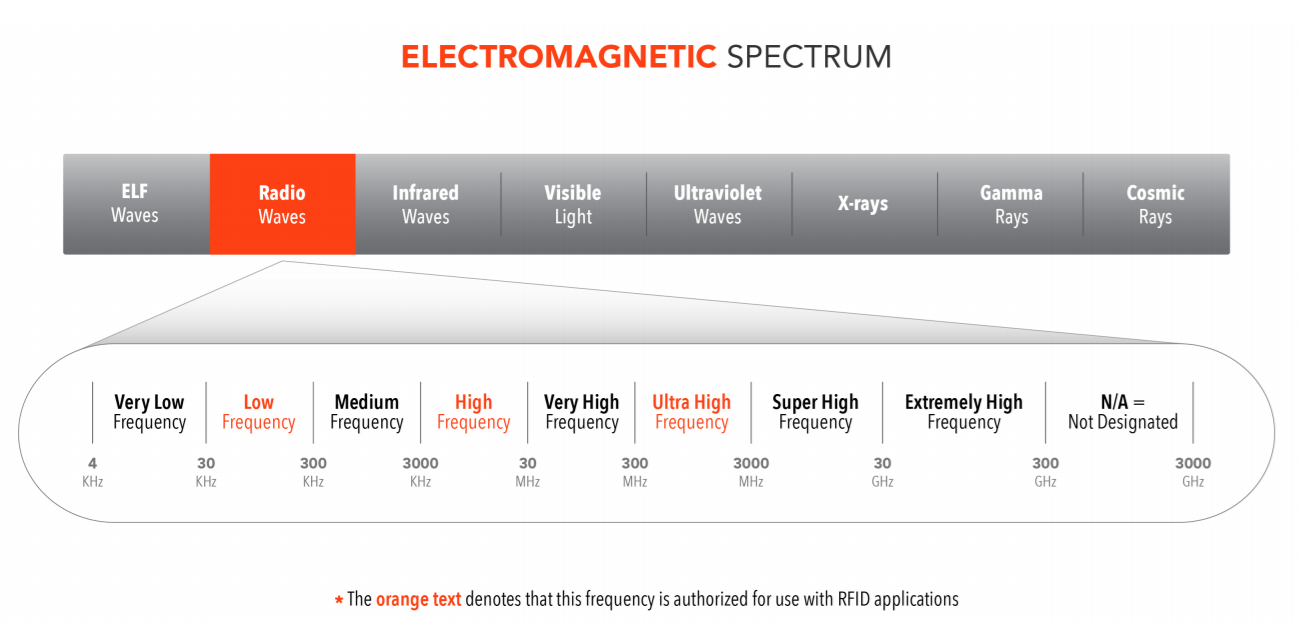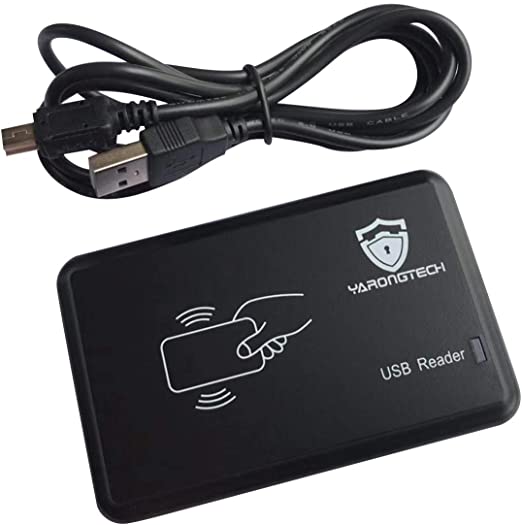Which RFID Frequency is Right for Your Application?
Originally published 10/29/2012 - Updated on 02/07/2025 with new information
RFID Frequency Ranges - LF, HF, and UHF

RFID tags and readers operate on a frequency band – similar to AM/FM radios.
FM radios operate on a frequency band between 88 and 108 MHz called VHF, or Very High Frequency, which means that you can listen to radio channels like 88.5, 98.1, or 107.7 MHz. While AM radios operate on the frequency band 540 – 1700 kHz, called the Medium Frequency or MF Band, and Satellite radio operates on the S-band which is the 2.3 GHz in North America.
Radio signals are essentially just electromagnetic signals that are broadcast from a location with a message or data included in the signal. A receiver, like your car radio, "tunes" into the frequency of the signal and extracts the message for you.
Just like the radio in your car, an RFID reader is "tuned" to the specific frequency of your tags and provides you with the information encoded to your tags.RFID technology has 3 main bands, or channel groupings – LH, HF, and UHF. You can think of these sort of like AM, FM, and Satellite radio – they each have specific pros, cons, and usages.
The three common frequency bands for RFID are below and include the frequency range:
- Low frequency, or LF, (125 - 134 kHz)
- High frequency, or HF, (13.56 MHz)
- Ultra-high frequency, or UHF, (433 MHz, and 860-960 MHz)
Radio waves behave differently at the various frequencies, so it is imperative to select the right frequency for your application.
RFID Frequencies – Low Frequency (LF) RFID
Low Frequency RFID is similar to AM radio in our example above because both operate on the lowest frequencies compared to their counterparts, which allows them to travel through denser materials. Low Frequency (LF) is used in very specific use cases because it has a very short read range – an LF RFID tag can only be read from a few centimeters, to about an inch away.
The reason LF tags have such a short read range is because they have a long wavelength and communicate via magnetic coupling. Magnetic coupling (like magnets) can only be accomplished at a few centimeters, but the benefit is that these tags can be read through virtually any substance. LF tags can be read with an LF reader through water, metal – two difficult materials for other RFID frequencies.
Because of the ability to read through water and metal, LF RFID systems are ideal for reading objects with high-water content, such as fruit or beverages, and even animals. Typical LF RFID applications include access control and animal tagging for identification.
To learn in more detail about LF RFID, checkout these three resources on our blog.
RFID Frequencies – High Frequency (HF) RFID
High Frequency RFID is similar to FM radio in our example above, because it’s the most widespread RFID frequency used on a daily basis. Any type of tap to pay, tap to share, or tap to read technology is most likely using HF RFID. HF RFID has a pretty short read range, of only a few inches at most, which makes it ideal for smartphones and credit card payments.
The unique aspect of HF RFID is that, although it uses the frequency band 3 – 30 MHz, most use cases only use one specific band – 13.56 MHz. This is because an international organization, the NFC Forum, established that NFC, or Near-Field Communication would only operate at that one frequency – 13.56 MHz. This is so that an international standard could be set so that all companies can create products that work together – seamlessly.
High-frequency and NFC tags work fairly well on objects made of metal and can work around goods with medium to high water content. Typically, HF RFID systems work in ranges of inches, but they can have a maximum read range of about three feet (1 meter). HF RFID applications include payments, library book/media management, patient flow tracking, and transit tickets.
To learn in more detail about HF RFID, checkout these three resources on our blog.
RFID Frequencies – Ultra-High Frequency (UHF) RFID
Ultra-High Frequency, or UHF RFID, can be compared to satellite radio in our example above (or a music streaming platform – i.e. Spotify), because it’s more of a technology that is on the rise and can be used for a large number of applications. Satellite radio and UHF RFID also operate on the highest frequencies compared to their counterparts.
UHF RFID has a much larger range than LF RFID or HF RFID, with the ability to read around 30 feet in distance, depending on the specific RFID tag and hardware used. Each UHF RFID tag has an average read range associated with it, and these can vary greatly – from 1 foot, to over 50 feet in distance. While UHF RFID has a vast read range (and a large frequency range), it has problems with read on or close to metal and water. UHF RFID tags have been created that lessen the problems with water and metal, but they do not fix it completely.
UHF frequencies typically offer much better read and can transfer data faster (i.e. read many more tags per second) than low- and high-frequencies. Due to their high data transfer rate, UHF RFID tags are well suited for many items at once, such as boxes of goods as they pass through a dock door into a warehouse or racers as they cross a finish line.
Due to the longer read range, other common UHF RFID applications include retail inventory management, electronic tolling, timing races and marathons, tracking medium to high value assets, vehicle identification and access control, event ticketing and access, and many more.
To learn in more detail about UHF RFID, checkout these three resources on our blog.
To learn about specific country regulations for UHF RFID frequencies, take a look at our article “UHF RFID Frequency Regulations”.
Conclusion
If you have any questions regarding frequency, please leave a comment below or contact us directly. If you would like to learn more about all things RFID, check out our website, our YouTube channel, comment below, or contact us.


